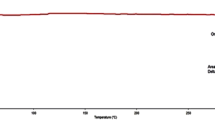Abstract
Herein a study on the process of converting omeprazole into omeprazole vesicles by a film dispersion method is presented. Using encapsulation efficiency as an index, the formulation and technology of omeprazole vesicles are optimized by a single factor experiment and a central composite design-response surface method. The optimized formulation and technology are as follows: the ratio of Tween-80 to cholesterol is 3 : 1, the hydration time is 65 min, the hydration temperature is 30°C, and hydration solvent pH is 11. Under such conditions, the average particle diameter of the obtained the omeprazole vesicles is 70 nm, and the encapsulation efficiency is 92.40%, which is close to the theoretical value of 93.43%. Transmission electron microscope (TEM) characterization reveals that the omeprazole vesicles are of regular spherical shape, and IR and TG characterization demonstrate that omeprazole has been encapsulated by the vesicles. The release time of pure omeprazole drug in simulated human intestinal fluid (pH = 6.8) is about 70 min, and the release time of omeprazole vesicles is ca 75 min, with a release rate of 33.19%.






Similar content being viewed by others
REFERENCES
Handjani-Vila, R.M., Ribier, A., Rondot, B., and Vanlerberghie, G., Int. J. Cosmetic Sci., 1979, vol. 1, p. 303. https://doi.org/10.1111/j.1467-2494.1979.tb00224.x
Gopinath, D., Ravi, D., Rao, B.R., Apte, S.S., Renuka, D., and Rambhau, D., Int. J. Pharmaceut., 2004, vol. 271, p. 95. https://doi.org/10.1016/j.ijpharm.2003.10.032
Hong, J.D., M. Sci. Thesis, South China University of Technology, China, 2019.
Bragagni, M., Mennini, N., Furlanetto, S., Orlandini, S., and Mura, P., Eur. J. Pharm. Biopharm., 2014, vol. 87, p. 73. https://doi.org/10.1016/j.ejpb.2014.01.006
Didem, A.S., Muharrem, S., Johanna-Gabriela, W., Frank, S., and Thomas, S., J. Nanomater., 2016, article ID 7372306. https://doi.org/10.1155/2016/7372306
Le Meins, J.-F., Sandre, O., and Lecommandoux, S., Eur. Phys. J. E., 2011, vol. 34, p. 14. https://doi.org/10.1140/epje/i2011-11014-y
Kaler, E.W., Murthy, A.K., Rodriguez, B.E., and Zasadzinski, J.A.N., Science, 1989, vol. 245, p. 1371.
Ma, J., M. Sci. Thesis, Jiang Nan University, China, 2015.
Overmoyer, B., Silverman, P., Holder, L.W., Tripathy, D., and Henderson, I.C., Clin. Breast Cancer, 2006, vol. 6, p. 150. https://doi.org/10.3816/CBC.2005.n.017
Cheng, J.Y., Huang, H.N., Tseng, W.C., Li, T.L., Chan, Y.L., and Cheng, K.C., J. Control. Release., 2009, vol. 135, p. 242. https://doi.org/10.1016/j.jconrel.2009.01.014
Olsen, K.M., Bergman, K.L., Kaufman, S.S., Rebuck, J.A., and Collier, D.S., Pediatr. Crit. Care. Med., 2001, vol. 2, p. 232. https://doi.org/10.1097/00130478-200107000-00008
Larsson, H., Mattson, H., Sundell, G., and Carlsson, E., Scand. J. Gastroenter., 1985, vol. 20, p. 23. https://doi.org/10.3109/00365528509095817
Katashima, M., Yamamoto, K., Tokuma, Y., Hata T., Sawada, Y., and Iga, T., Eur. J. Drug. Metab. Ph. 1998, vol. 23, p. 19. https://doi.org/10.1007/BF03189822
Barth, J., and Hahne, W., Aliment. Pham. Ther., 2015, vol.16, p. 31. https://doi.org/10.1046/j.1365-2036.2002.0160s1031.x
Abraham, N.S., Curr. Opin. Gastroen., 2012, vol. 28, p. 615. https://doi.org/10.1097/MOG.0b013e328358d5b9
Reenstra, W.W., Bettencourt, J.D., and Forte, J.G., Am. J. Physiol., 1986, vol. 250, p. 455. https://doi.org/10.1152/ajpgi.1986.250.4.G455
Guan, Y.B., Han, B., Tian, Y.D., Jia, Y.Y., and Sun, Y.J., Chin. Med. Mater., 2019, vol. 42, p. 385. https://doi.org/10.13863/j.issn1001-4454.2019.02.032
Wang, X.X., M. Sci. Thesis, Qingdao University of Science and Technology, China, 2017.
Zheng, C.J., Li, S.S., and Chen, Q., Fine Chem., 2020, vol. 37, p. 2482. https://doi.org/10.13550/j.jxhg.20200656
Xu, D.Q., Liu, X.H., Sun, S.M., Jin, C.C., Yi, J., Wang, X.Y., and Guo, B.H., Lishizhen Med. Mater. Med. Res., 2017, vol. 28, p. 600.
Mansaray, K.G. and Ghaly, A.E., Biomass Bioenerg., 1999, vol. 17, p. 19. https://doi.org/10.1016/S0961-9534(99)00022-7
Tu, X.Y., M. Sci. Thesis, Guizhou University, China, 2019.
Li, S.S., M. Sci. Thesis, Guizhou University, China, 2020.
Chen, X.H., Zhang, Q.Z., Chen, J., and Zhang, W.H., J. Light Scattering, 2009, vol. 21, p. 325. https://doi.org/10.13883/j.issn1004-5929.2009.04.016
Author information
Authors and Affiliations
Corresponding authors
Ethics declarations
No conflict of interest was declared by the authors.
Rights and permissions
About this article
Cite this article
Deng, W., Wang, Z., Zhang, Y. et al. Study on the Preparation Technology of Omeprazole Vesicles. Russ J Gen Chem 91, 2311–2319 (2021). https://doi.org/10.1134/S1070363221110190
Received:
Revised:
Accepted:
Published:
Issue Date:
DOI: https://doi.org/10.1134/S1070363221110190




